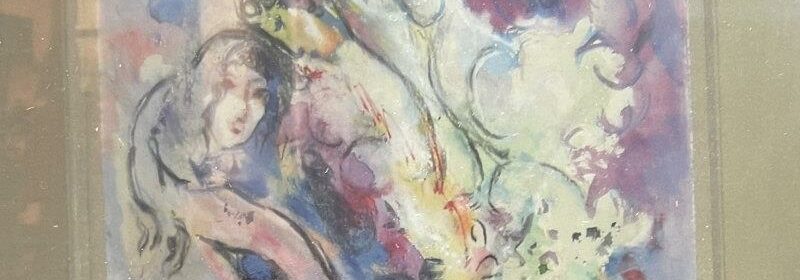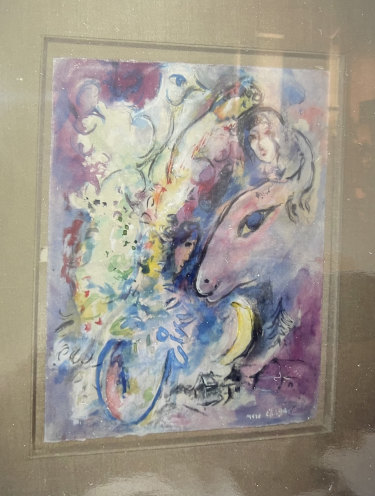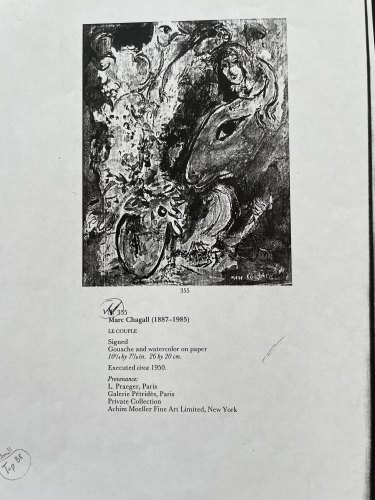What happens when a ‘Chagall’ is sold, and it turns out to be fake

The question of whether a valuable artwork is genuine can be surprisingly fluid, changing over time based on evolving and sometime competing evaluations.
A signed watercolor and gouache on paper that was sold at auction by Sotheby’s in 1994 as a work by Marc Chagall. An expert panel in France now wants to destroy it as a fake. Credit:New York Times
In 1973, for example, the Metropolitan Museum of Art re-attributed roughly 300 paintings in its collection, including works long thought to have been created by masters such as Rembrandt, Goya, Vermeer and Velázquez.
“I believe that attributions are like medicine or any field in which knowledge is constantly changing or advancing,” offered Everett Fahy, the Met’s curator of European paintings at that time.
Some 37 years later, the museum decided it had actually been right the first time around, and flipped back the attribution for one of those works, a portrait of Phillip IV by Velázquez.
This sort of history is of little solace to Stephanie Clegg, who paid $US90,000 for a painting attributed to Marc Chagall at auction at Sotheby’s in 1994, just nine years after the artist’s death.
Two years ago, when she was looking to sell works from her collection, Sotheby’s suggested it might be a good time to auction her Chagall, Clegg said. But the company told her it would have to send the work to France for authentication by a panel of Chagall experts.
Stephanie Clegg, an art collector who purchased a purported Marc Chagall painting at Sotheby’s in 1994 that has now been declared a fake.Credit:New York Times
Sotheby’s described the review as a formality, Clegg said, and she agreed, deciding that she had little reason to worry. The auction house, after all, had sold the work as a Chagall and raised no doubt as to its attribution in 2008 when it reappraised the watercolour at a value of $100,000.
But, to Clegg’s dismay, the expert panel in Paris declared her Chagall to be fake, held on to it and now wants to destroy it.
When she complained to Sotheby’s, the auction house said there was little it could do, saying its guarantee of authenticity was good only for a time. The company has offered her an $18,500 credit towards their fee on any future sales of artworks she owns, a gesture she calls inadequate.
“I trusted them through all those years,” Clegg, 73, said in an interview. “They were supposed to be reputable experts and I relied on their expertise.”
Now Clegg is in a standoff. Through her lawyer, she has asked Sotheby’s for $175,000. The auction house says there is no legal basis for that request and the discount it has offered on future sales would match the fee it earned from the 1994 sale of the painting.
“Given that the initial sale took place well over 20 years ago, we are far outside the period of time during which Sotheby’s guaranteed the authorship of the work and would have had any recourse with the seller,” an auction house executive told Clegg in a 2020 letter.
Among the vagaries that make the art world such a compelling, if risky, marketplace is the fact a change in attribution can sink the value of one work, or swell the value of another. Case in point: the Salvator Mundi, which reportedly sold at auction in 2005 for $1175 when it was thought to be by a nobody, and then soared to sell for $450 million in 2017, after several experts decided it was the work of Leonardo da Vinci.
Auction houses have sought to reduce their exposure to unfavorable changes in attribution by limiting the time they will guarantee that a work is genuine. In Sotheby’s case, it tells buyers that it will warrant the work for five years.
Clegg contends Sotheby’s bears more responsibility than it is accepting for the situation she is in, given its extensive involvement with the painting — as the original auction house, subsequent appraiser and recent adviser on its potential resale. Her lawyer, Carter Reich, has accused the auction house in a letter of “breach of contract, fraudulent misrepresentation, negligence and breach of fiduciary duty”.
Lawyers for Sotheby’s have denied all those claims, arguing the auction house acted responsibly and in accord with its standards and procedures.
Clegg has held on to the page from the 1994 Sotheby’s catalogue that advertised the work, a signed watercolour and gouache on paper titled Le couple au bouquet de fleurs. The catalogue said Chagall had created it about1950 and it listed the painting’s previous owners as L. Praeger, Galerie Pétridès, both of Paris; a private collection; and then Achim Moeller Fine Art Ltd. in New York.
In an email, Achim Moeller said he had no memory of being involved with that work but added through his lawyer that he would research his gallery records.
Sotheby’s auction catalogue identifying the page from the 1994 catalogue that advertised the work, a signed watercolor and gouache on paper titled Le couple au bouquet de fleurs.Credit:New York Times
Sotheby’s pointed out in a statement that, while it is rare, there are occasions when new and revised scholarship results in works being deemed inauthentic, something the auction house does not make assurances against.
“Sotheby’s respects and maintains the confidentiality of its consignors and buyers, and does not comment on matters that are not of public record,” the statement said, adding: “This particular work was known to the market, and was traded multiple times prior to the auction in 1994.”
The Chagall hung for years on the wall of the bedroom Clegg shared with her husband, Alfred John Clegg, before going into storage when she moved to a smaller home. That’s where it was, she said, when Sotheby’s suggested in early 2020 that if she were interested in selling, her Chagall might do well. The work was shipped to the Comité Marc Chagall, a panel of experts founded in 1988 that makes decisions on the authenticity of works attributed to the artist.
In late 2020, the panel released its findings regarding her work. In a letter to Clegg, Meret Meyer, one of Chagall’s granddaughters and a member of the panel, reported that it had unanimously found the work to be inauthentic, adding that it is an amalgam of several other works including “Le couple au bouquet,” from about 1952, and “Les amoureux au cheval” from 1961.
Clegg’s painting included “recurrent iconographic elements of Chagall’s work,” including a bouquet, lovers, a horse profile, a rooster profile, a village silhouette and a crescent moon, the committee wrote but those lacked “real presence,” according to a translation provided by Clegg’s lawyer. The letter went on to say that Chagall’s heirs were requesting the “judicial seizure” of the painting “so that the work may be destroyed”.
In France, courts have recognised the authority of expert panels to destroy works determined to be counterfeit.
Nearly a decade ago, the Chagall panel moved to destroy a work, “Nude 1909-10,” that a British businessman, Martin Lang, had bought in 1992 for £100,000, thinking it was by Chagall, the BBC reported. Lang objected but then tweeted in early 2014: “I have decided not to fight this expensive court battle! These committees lack human compassion!”
Several authentication committees have been sued after ruling that a work was not genuine and panels that officially reviewed the works by Jean-Michel Basquiat, Andy Warhol and Jackson Pollock have disbanded. Clegg’s lawyer, Reich, declined to comment on the possibility of suing the Chagall committee.
Clegg has instead pursued Sotheby’s. In a letter to the auction house, Reich wrote it had “falsely and recklessly assured” her the committee rarely seized works and she had nothing to worry about. He also wrote Sotheby’s had told Clegg “additional research would be conducted” before the painting was sent to the committee, but that no research was performed.
In rejecting the claim that it bears responsibility for Clegg’s situation, Sotheby’s isn’t relying solely on the fact the auction house’s warranty of authenticity had expired. Sotheby’s also has said through its lawyers that it apprised Clegg in writing of the risks of submission to the committee. They added that any statements to Clegg about the likelihood of seizure by the Chagall panel were only expressing expectations, noting that she had signed a release indemnifying Sotheby’s from any claims connected to that submission.
For Clegg the matter boils down to a simple formulation.
“I bought this painting through Sotheby’s as an authentic painting at the authentic price,” she said. “I think they should stand by that.”
This article originally appeared in The New York Times.
Most Viewed in Culture
From our partners
Source: Read Full Article


